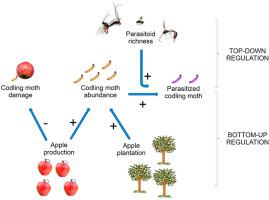Crop Protection ( IF 2.8 ) Pub Date : 2021-01-26 , DOI: 10.1016/j.cropro.2021.105545 Rodrigo Martínez-Sastre , Rocío Peña , Alejandro González-Ibáñez , Daniel García , Marcos Miñarro

|
The success of biological control by natural enemies in agricultural crops relies on an understanding of the trophic interactions between natural enemies, pests and host plants. Top-down and bottom-up trophic effects, together with potential landscape and local-scale factors, may regulate pest populations. For two years, we analyzed codling moth populations (Cydia pomonella), their crop damage and their parasitoid communities in 26 low-input cider apple orchards in northern Spain. Codling moth abundance was estimated from overwintering larvae sampled with cardboard traps on trees, parasitism was estimated from parasitoids emerged from lab-reared moth larvae, and pest damage was assessed in apples before ripening. Codling moth abundance differed between orchards across years, and was positively correlated with apple production and the cover of apple plantations in the surrounding landscape. The effects of the apple production on codling moth abundance suggest bottom-up pest regulation. Apple damage in individual orchards reached 71%, but decreased with apple production, indicating codling moth satiation. Seven parasitoid species were recorded on codling moth larvae. Parasitism rate in individual orchards reached 42.5% of codling moth larvae. The number of parasitized larvae per orchard was positively related to parasitoid richness, but also to codling moth abundance, suggesting simultaneous top-down and bottom-up effects between parasitoids and pest. This study highlights the need to tackle the whole parasitoid-pest-plant system in order to better manage codling moth damage in orchards. The conservation of complementary parasitoid species through biodiversity-friendly actions should be combined with the control of apple production at the orchard- and landscape scale.
中文翻译:

苹果酒果园中苹果mo蛾种群的自上而下和自下而上的调控
天敌在农作物中进行生物防治的成功取决于对天敌,害虫和寄主植物之间营养相互作用的理解。自上而下和自下而上的营养作用,以及潜在的景观和地方尺度因素,可能会调节有害生物种群。两年来,我们分析了苹果mo蛾种群(Cydia pomonella),西班牙北部的26个低投入苹果酒苹果园中的农作物受损以及其类寄生虫群落。幼虫蛾的丰度是从树上用纸板收集器取样的越冬幼虫中估计出来的,寄生虫是从实验室饲养的蛾幼虫中出现的寄生虫中估计出的寄生,并在成熟前对苹果中的害虫进行了评估。果园中的苹果蛾蛾数量多年不同,并且与苹果产量和周围景观中苹果园的覆盖率呈正相关。苹果生产对d蛾数量的影响表明了自下而上的害虫调控。单个果园中的苹果损害达到71%,但随着苹果产量的下降而减少,表明苹果co蛾饱食。在co蛾幼虫上记录了七种寄生虫。果园寄生率达到42。5%的苹果mo蛾幼虫。每个果园中被寄生的幼虫数量与拟寄生虫的丰富度呈正相关,但与幼虫蛾的丰度也呈正相关,这表明寄生虫和害虫同时具有自顶向下和自底向上的作用。这项研究强调需要解决整个寄生虫-害虫-植物系统,以便更好地处理果园中的苹果d蛾危害。通过对生物多样性有利的行动来保护互补的寄生类动物,应与在果园和景观规模上控制苹果产量相结合。这项研究强调需要解决整个寄生虫-害虫-植物系统,以便更好地处理果园中的苹果d蛾危害。通过对生物多样性有利的行动来保护互补的寄生类动物,应与在果园和景观规模上控制苹果产量相结合。这项研究强调需要解决整个寄生虫-害虫-植物系统,以便更好地处理果园中的苹果d蛾危害。通过对生物多样性有利的行动来保护互补的寄生类动物,应与在果园和景观规模上控制苹果产量相结合。


























 京公网安备 11010802027423号
京公网安备 11010802027423号